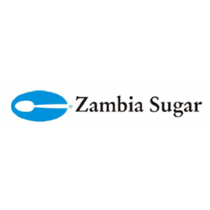Zambia Sugar
Zambia Sugar Plc, is the largest sugar-manufacturing company in Zambia, with annual output in excess of 318,467 tonnes (351,050 tons) of crystalline sugar annually, as of November 2018.[3] The company stock is listed of the Lusaka Stock Exchange, where the shares trade under the symbol: ZSUG.[4]
 | |
| Public | |
| Traded as | Lusaka Stock Exchange:ZSUG |
| Industry | Agriculture |
| Headquarters | Mazabuka, Zambia |
Area served | Zambia, Africa |
Key people | Rebecca Katowa Chief Executive Officer[1] Raphael Chipoma Chief Financial Officer |
| Products | Sugar Sugar marketing |
| Revenue | |
| Total assets | ZMW:3,949,763,000 (US$217 million) (2019)[2] |
| Total equity | ZMW:1,412,679,000 (US$78 million) (2019)[2] |
Number of employees | 6,014 (2014) |
| Website | Homepage |
Location
The company headquarters are located in the town of Mazabuka, in Mazabuka District, in the Southern Province, Zambia. The company owns, operates and maintains Nakambala Sugar Estates, located in Nakambala, a suburb of Mazabuka, approximately 141 kilometres (88 mi) by road, southwest of Lusaka, the national capital and largest city in Zambia.[5] The geographical coordinates of Nakambala are:15°49'58.0"S, 27°46'53.0"E (Latitude:-15.832778; Longitude:27.781389).[6]
Overview
As of 31 December 2019, the company's total assets were ZMW:3,949,763,000 (US$217 million), with shareholders' equity of ZMW:1,412,679,000 (US$78 million).[2]
History
The Nakambala Sugar Estate was founded in 1964 by Tate & Lyle Limited, on the southeastern edge of the Kafue Flats at Mazabuka. By 1968 the estate was growing sugar cane on 1,680 hectares (4,200 acres), using the sugar mill which had been moved from Tate & Lyle's failed sugar operation at Chirundu and irrigation water from the Kafue River. By 1976 the estate was producing 68,000 tonnes (74,957 tons) of sugar from 6,650 hectares (16,400 acres) under cultivation. Production rose to over 90,000 tonnes (99,208 tons) of refined sugar from 9,000 hectares (22,239 acres) of farmland, by 1983.[7]
In 1972 the Zambia Sugar Company Limited, which operated the estate, was nationalised and Industrial Development Corporation of Zambia (then abbreviated INDECO) acquired 51 percent of the shares of the company, while Tate and Lyle retained 49 percent. In 1975 INDECO raised their stake to 75 percent, with Tate and Lyle retaining 11 percent, with the remaining 14 percent being taken up by other private investors.[8]
In 1995 Zambia Sugar Company Limited was repurchased by Tate & Lyle, who increased their stake to 51 percent, Commonwealth Development Corporation (CDC Group) took up 31 percent and the remaining 18 percent was acquired by Zambia Privatisation Trust Fund. In 1996 the company floated its shares of stock on the Lusaka Stock Exchange as Zambia Sugar Plc.[8] In 2001 Tate and Lyle sold its interest in Zambia Sugar Plc to Illovo Sugar of South Africa. Illovo made an offer to minority shareholders, as required by Zambian law, and increased shareholding to 90 percent. By 2006, sugar production had increased to 240,000 tons annually.[8]
Between 2007 and 2010 the company implemented a major expansion program and increased the area in production from 11,000 hectares (42 sq mi) to nearly 17,000 hectares (66 sq mi) of irrigated farmland. In 2009, Zambia Sugar Plc acquired a controlling interest in Nanga Farms Plc, who owned sugar farms adjacent to Nakambala with production capacity in excess of 350,000 tones of raw cane annually. That same year, Illovo reduced shareholding to 81.6 percent. Illovo Group Holding Limited reduced shareholding in Zambia Sugar Plc to 75 percent in 2014, to comply with new rules at the Lusaka Stock Exchange.[8]
Operations
In 2013, the company launched the Manyonyo Outgrower Scheme, an initiative of the government of Zambia, funded by the government of Finland and the African Development Bank. It involves 145 small-sale farmers who grow sugarcane on their land and sell the raw cane to the company.[8]
As of 2014, Zambia Sugar Public Limited Company employed 6,014 people, some of whom were permanent, others temporary and still others were seasonal.[9]
Ownership
The shares of stock of Zambia Sugar Plc are listed on the Lusaka Stock Exchange, where they trade under the symbol: ZSUG. The table below illustrates the shareholding in the company as of 31 August 2017.[10]
| Rank | Name of Owner | Percentage Ownership |
|---|---|---|
| 1 | Illovo Group Holdings Limited | |
| 2 | Pension Funds | |
| 3 | Zambian Companies | |
| 4 | Zambian Individuals | |
| 5 | Non-Zambian Individuals | |
| 6 | Non-Zambian companies | |
| Total | ||
See also
- Illovo Sugar
- Zambia Sugar Open
References
- Founder Fi (6 November 2019). "Rebecca Katowa's Zambia Sugar finally declares a dividend to shareholders". Lusaka: Financial Insight Zambia Limited. Retrieved 31 May 2020.
- Zambia Sugar (5 November 2019). "Abridged Financial Statement for the Year Ended 31 August 2019". Zambia Sugar Plc. Retrieved 31 May 2020.
- African Financials (12 November 2018). "Zambia Sugar averages 120 tons cane per hectare in FY`18". Africanfinancials.com. Retrieved 30 May 2020.
- Illovo Sugar Africa (30 October 2019). "Zambia Sugar Plc Trading Statement As Of 30 October 2019" (PDF). Lusaka: Illovo Sugar Africa. Retrieved 30 May 2020.
- Google (30 May 2020). "Road Distance Between Lusaka And Nakambala Sugar Estates" (Map). Google Maps. Google. Retrieved 30 May 2020.
- Google (30 May 2020). "Location of Nakambala Sugar Estates" (Map). Google Maps. Google. Retrieved 30 May 2020.
- Zambia Water Forum (2019). "Field Trip: Nakambula Sugar Estates". Lusaka: Zambiawaterforum.org. Retrieved 30 May 2020.
- Zambia Sugar Limited (2016). "History of Zambia Sugar Plc: 2015 Annual Report: Milestones" (Cached on 30 May 2020). Mazabuka: Zambia Sugar Public Limited Company. Retrieved 30 May 2020.
- Zambia Sugar Plc (2014). "Illovo Zambia Social Economic Impact Assessment" (PDF). Mazabuka: Zambia Sugar Public Limited Company. Retrieved 30 May 2020.
- Zambia Sugar Plc (31 October 2017). "Zambia Sugar Plc Annual Report for the Period Ending 31 August 2017". Zambia Sugar Public Limited Company. Retrieved 31 May 2020.